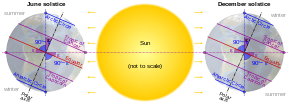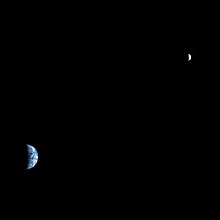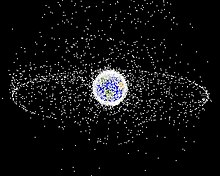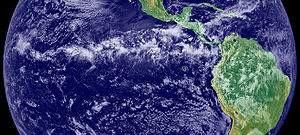EARTH 3
Axial tilt and seasons
Main article: Axial tilt § Earth Earth's axial tilt causing different angles of seasonal illumination at different orbital positions around the Sun
Earth's axial tilt causing different angles of seasonal illumination at different orbital positions around the Sun
The axial tilt of Earth is approximately 23.439281°[2] with the axis of its orbit plane, always pointing towards the Celestial Poles. Due to Earth's axial tilt, the amount of sunlight reaching any given point on the surface varies over the course of the year. This causes the seasonal change in climate, with summer in the Northern Hemisphere occurring when the Tropic of Cancer is facing the Sun, and in the Southern Hemisphere when the Tropic of Capricorn faces the Sun. In each instance, winter occurs simultaneously in the opposite hemisphere.
During the summer, the day lasts longer, and the Sun climbs higher in the sky. In winter, the climate becomes cooler and the days shorter.[163] Above the Arctic Circle and below the Antarctic Circle there is no daylight at all for part of the year, causing a polar night, and this night extends for several months at the poles themselves. These same latitudes also experience a midnight sun, where the sun remains visible all day.[164][165]
By astronomical convention, the four seasons can be determined by the solstices—the points in the orbit of maximum axial tilt toward or away from the Sun—and the equinoxes, when Earth's rotational axis is aligned with its orbital axis. In the Northern Hemisphere, winter solstice currently occurs around 21 December; summer solstice is near 21 June, spring equinox is around 20 March and autumnal equinox is about 22 or 23 September. In the Southern Hemisphere, the situation is reversed, with the summer and winter solstices exchanged and the spring and autumnal equinox dates swapped.[166]
The angle of Earth's axial tilt is relatively stable over long periods of time. Its axial tilt does undergo nutation; a slight, irregular motion with a main period of 18.6 years.[167] The orientation (rather than the angle) of Earth's axis also changes over time, precessing around in a complete circle over each 25,800-year cycle; this precession is the reason for the difference between a sidereal year and a tropical year. Both of these motions are caused by the varying attraction of the Sun and the Moon on Earth's equatorial bulge. The poles also migrate a few meters across Earth's surface. This polar motion has multiple, cyclical components, which collectively are termed quasiperiodic motion. In addition to an annual component to this motion, there is a 14-month cycle called the Chandler wobble. Earth's rotational velocity also varies in a phenomenon known as length-of-day variation.[168]
In modern times, Earth's perihelion occurs around 3 January, and its aphelion around 4 July. These dates change over time due to precession and other orbital factors, which follow cyclical patterns known as Milankovitch cycles. The changing Earth–Sun distance causes an increase of about 6.8% in solar energy reaching Earth at perihelion relative to aphelion.[169][n 11] Because the Southern Hemisphere is tilted toward the Sun at about the same time that Earth reaches the closest approach to the Sun, the Southern Hemisphere receives slightly more energy from the Sun than does the northern over the course of a year. This effect is much less significant than the total energy change due to the axial tilt, and most of the excess energy is absorbed by the higher proportion of water in the Southern Hemisphere.[170]
Earth–Moon system
Further information: Satellite system (astronomy)
Moon
Main articles: Moon, Lunar theory, and Orbit of the Moon Earth and the Moon as seen from Mars by the Mars Reconnaissance Orbiter
Earth and the Moon as seen from Mars by the Mars Reconnaissance Orbiter View of Earth from the Moon by the Lunar Reconnaissance Orbiter
View of Earth from the Moon by the Lunar Reconnaissance Orbiter
The Moon is a relatively large, terrestrial, planet-like natural satellite, with a diameter about one-quarter of Earth's. It is the largest moon in the Solar System relative to the size of its planet, although Charon is larger relative to the dwarf planet Pluto.[171][172] The natural satellites of other planets are also referred to as "moons", after Earth's.[173] The most widely accepted theory of the Moon's origin, the giant-impact hypothesis, states that it formed from the collision of a Mars-size protoplanet called Theia with the early Earth. This hypothesis explains the Moon's relative lack of iron and volatile elements and the fact that its composition is nearly identical to that of Earth's crust.[40]
The gravitational attraction between Earth and the Moon causes tides on Earth.[174] The same effect on the Moon has led to its tidal locking: its rotation period is the same as the time it takes to orbit Earth. As a result, it always presents the same face to the planet.[175] As the Moon orbits Earth, different parts of its face are illuminated by the Sun, leading to the lunar phases.[176] Due to their tidal interaction, the Moon recedes from Earth at the rate of approximately 38 mm/a (1.5 in/year). Over millions of years, these tiny modifications—and the lengthening of Earth's day by about 23 µs/yr—add up to significant changes.[177] During the Ediacaran period, for example, (approximately 620 Ma) there were 400±7 days in a year, with each day lasting 21.9±0.4 hours.[178]
The Moon may have dramatically affected the development of life by moderating the planet's climate. Paleontological evidence and computer simulations show that Earth's axial tilt is stabilized by tidal interactions with the Moon.[179] Some theorists think that without this stabilization against the torques applied by the Sun and planets to Earth's equatorial bulge, the rotational axis might be chaotically unstable, exhibiting large changes over millions of years, as is the case for Mars, though this is disputed.[180][181]
Viewed from Earth, the Moon is just far enough away to have almost the same apparent-sized disk as the Sun. The angular size (or solid angle) of these two bodies match because, although the Sun's diameter is about 400 times as large as the Moon's, it is also 400 times more distant.[159] This allows total and annular solar eclipses to occur on Earth.[182]
On 1 November 2023, scientists reported that, according to computer simulations, remnants of a protoplanet, named Theia, could be inside the Earth, left over from a collision with the Earth in ancient times, and afterwards becoming the Moon.[183][184]
Asteroids and artificial satellites
Main articles: Near-Earth object and Claimed moons of Earth A computer-generated image mapping the prevalence of artificial satellites and space debris around Earth in geosynchronous and low Earth orbit
A computer-generated image mapping the prevalence of artificial satellites and space debris around Earth in geosynchronous and low Earth orbit
Earth's co-orbital asteroids population consists of quasi-satellites, objects with a horseshoe orbit and trojans. There are at least five quasi-satellites, including 469219 Kamoʻoalewa.[185][186] A trojan asteroid companion, 2010 TK7, is librating around the leading Lagrange triangular point, L4, in Earth's orbit around the Sun.[187] The tiny near-Earth asteroid 2006 RH120 makes close approaches to the Earth–Moon system roughly every twenty years. During these approaches, it can orbit Earth for brief periods of time.[188]
As of September 2021, there are 4,550 operational, human-made satellites orbiting Earth.[189] There are also inoperative satellites, including Vanguard 1, the oldest satellite currently in orbit, and over 16,000 pieces of tracked space debris.[n 12] Earth's largest artificial satellite is the International Space Station.[190]
Hydrosphere
Main article: Hydrosphere A view of Earth with its global ocean and cloud cover, which dominate Earth's surface and hydrosphere; at Earth's polar regions, its hydrosphere forms larger areas of ice cover.
A view of Earth with its global ocean and cloud cover, which dominate Earth's surface and hydrosphere; at Earth's polar regions, its hydrosphere forms larger areas of ice cover.
Earth's hydrosphere is the sum of Earth's water and its distribution. Most of Earth's hydrosphere consists of Earth's global ocean. Earth's hydrosphere also consists of water in the atmosphere and on land, including clouds, inland seas, lakes, rivers, and underground waters down to a depth of 2,000 m (6,600 ft).
The mass of the oceans is approximately 1.35×1018 metric tons or about 1/4400 of Earth's total mass. The oceans cover an area of 361.8 million km2 (139.7 million sq mi) with a mean depth of 3,682 m (12,080 ft), resulting in an estimated volume of 1.332 billion km3 (320 million cu mi).[191] If all of Earth's crustal surface were at the same elevation as a smooth sphere, the depth of the resulting world ocean would be 2.7 to 2.8 km (1.68 to 1.74 mi).[192] About 97.5% of the water is saline; the remaining 2.5% is fresh water.[193][194] Most fresh water, about 68.7%, is present as ice in ice caps and glaciers.[195] The remaining 30% is ground water, 1% surface water (covering only 2.8% of Earth's land)[196] and other small forms of fresh water deposits such as permafrost, water vapor in the atmosphere, biological binding, etc. .[197][198]
In Earth's coldest regions, snow survives over the summer and changes into ice. This accumulated snow and ice eventually forms into glaciers, bodies of ice that flow under the influence of their own gravity. Alpine glaciers form in mountainous areas, whereas vast ice sheets form over land in polar regions. The flow of glaciers erodes the surface changing it dramatically, with the formation of U-shaped valleys and other landforms.[199] Sea ice in the Arctic covers an area about as big as the United States, although it is quickly retreating as a consequence of climate change.[200]
The average salinity of Earth's oceans is about 35 grams of salt per kilogram of seawater (3.5% salt).[201] Most of this salt was released from volcanic activity or extracted from cool igneous rocks.[202] The oceans are also a reservoir of dissolved atmospheric gases, which are essential for the survival of many aquatic life forms.[203] Sea water has an important influence on the world's climate, with the oceans acting as a large heat reservoir.[204] Shifts in the oceanic temperature distribution can cause significant weather shifts, such as the El Niño–Southern Oscillation.[205]
The abundance of water, particularly liquid water, on Earth's surface is a unique feature that distinguishes it from other planets in the Solar System. Solar System planets with considerable atmospheres do partly host atmospheric water vapor, but they lack surface conditions for stable surface water.[206] Despite some moons showing signs of large reservoirs of extraterrestrial liquid water, with possibly even more volume than Earth's ocean, all of them are large bodies of water under a kilometers thick frozen surface layer.[207]
Atmosphere
Main article: Atmosphere of Earth A view of Earth with different layers of its atmosphere visible: the troposphere with its clouds casting shadows, a band of stratospheric blue sky at the horizon, and a line of green airglow of the lower thermosphere around an altitude of 100 km, at the edge of space
A view of Earth with different layers of its atmosphere visible: the troposphere with its clouds casting shadows, a band of stratospheric blue sky at the horizon, and a line of green airglow of the lower thermosphere around an altitude of 100 km, at the edge of space
The atmospheric pressure at Earth's sea level averages 101.325 kPa (14.696 psi),[208] with a scale height of about 8.5 km (5.3 mi).[3] A dry atmosphere is composed of 78.084% nitrogen, 20.946% oxygen, 0.934% argon, and trace amounts of carbon dioxide and other gaseous molecules.[208] Water vapor content varies between 0.01% and 4%[208] but averages about 1%.[3] Clouds cover around two-thirds of Earth's surface, more so over oceans than land.[209] The height of the troposphere varies with latitude, ranging between 8 km (5 mi) at the poles to 17 km (11 mi) at the equator, with some variation resulting from weather and seasonal factors.[210]
Earth's biosphere has significantly altered its atmosphere. Oxygenic photosynthesis evolved 2.7 Gya, forming the primarily nitrogen–oxygen atmosphere of today.[63] This change enabled the proliferation of aerobic organisms and, indirectly, the formation of the ozone layer due to the subsequent conversion of atmospheric O2 into O3. The ozone layer blocks ultraviolet solar radiation, permitting life on land.[211] Other atmospheric functions important to life include transporting water vapor, providing useful gases, causing small meteors to burn up before they strike the surface, and moderating temperature.[212] This last phenomenon is the greenhouse effect: trace molecules within the atmosphere serve to capture thermal energy emitted from the surface, thereby raising the average temperature. Water vapor, carbon dioxide, methane, nitrous oxide, and ozone are the primary greenhouse gases in the atmosphere. Without this heat-retention effect, the average surface temperature would be −18 °C (0 °F), in contrast to the current +15 °C (59 °F),[213] and life on Earth probably would not exist in its current form.[214]
Weather and climate
Main articles: Weather and Climate
The ITCZ's band of clouds over the Eastern Pacific and the Americas as seen from space
Worldwide Köppen climate classifications
Earth's atmosphere has no definite boundary, gradually becoming thinner and fading into outer space.[215] Three-quarters of the atmosphere's mass is contained within the first 11 km (6.8 mi) of the surface; this lowest layer is called the troposphere.[216] Energy from the Sun heats this layer, and the surface below, causing expansion of the air. This lower-density air then rises and is replaced by cooler, higher-density air. The result is atmospheric circulation that drives the weather and climate through redistribution of thermal energy.[217]
The primary atmospheric circulation bands consist of the trade winds in the equatorial region below 30° latitude and the westerlies in the mid-latitudes between 30° and 60°.[218] Ocean heat content and currents are also important factors in determining climate, particularly the thermohaline circulation that distributes thermal energy from the equatorial oceans to the polar regions.[219]
Earth receives 1361 W/m2 of solar irradiance.[220][221] The amount of solar energy that reaches Earth's surface decreases with increasing latitude. At higher latitudes, the sunlight reaches the surface at lower angles, and it must pass through thicker columns of the atmosphere. As a result, the mean annual air temperature at sea level decreases by about 0.4 °C (0.7 °F) per degree of latitude from the equator.[222] Earth's surface can be subdivided into specific latitudinal belts of approximately homogeneous climate. Ranging from the equator to the polar regions, these are the tropical (or equatorial), subtropical, temperate and polar climates.[223]
Further factors that affect a location's climates are its proximity to oceans, the oceanic and atmospheric circulation, and topology.[224] Places close to oceans typically have colder summers and warmer winters, due to the fact that oceans can store large amounts of heat. The wind transports the cold or the heat of the ocean to the land.[225] Atmospheric circulation also plays an important role: San Francisco and Washington DC are both coastal cities at about the same latitude. San Francisco's climate is significantly more moderate as the prevailing wind direction is from sea to land.[226] Finally, temperatures decrease with height causing mountainous areas to be colder than low-lying areas.[227]
Water vapor generated through surface evaporation is transported by circulatory patterns in the atmosphere. When atmospheric conditions permit an uplift of warm, humid air, this water condenses and falls to the surface as precipitation.[217] Most of the water is then transported to lower elevations by river systems and usually returned to the oceans or deposited into lakes. This water cycle is a vital mechanism for supporting life on land and is a primary factor in the erosion of surface features over geological periods. Precipitation patterns vary widely, ranging from several meters of water per year to less than a millimeter. Atmospheric circulation, topographic features, and temperature differences determine the average precipitation that falls in each region.[228]
The commonly used Köppen climate classification system has five broad groups (humid tropics, arid, humid middle latitudes, continental and cold polar), which are further divided into more specific subtypes.[218] The Köppen system rates regions based on observed temperature and precipitation.[229] Surface air temperature can rise to around 55 °C (131 °F) in hot deserts, such as Death Valley, and can fall as low as −89 °C (−128 °F) in Antarctica.[230][231]
Upper atmosphere
 Earth's atmosphere as it appears from space, as bands of different colours at the horizon. From the bottom, afterglow illuminates the troposphere in orange with silhouettes of clouds, and the stratosphere in white and blue. Next the mesosphere (pink area) extends to just below the edge of space at one hundred kilometers and the pink line of airglow of the lower thermosphere (invisible), which hosts green and red aurorae over several hundred kilometers.
Earth's atmosphere as it appears from space, as bands of different colours at the horizon. From the bottom, afterglow illuminates the troposphere in orange with silhouettes of clouds, and the stratosphere in white and blue. Next the mesosphere (pink area) extends to just below the edge of space at one hundred kilometers and the pink line of airglow of the lower thermosphere (invisible), which hosts green and red aurorae over several hundred kilometers.
The upper atmosphere, the atmosphere above the troposphere,[232] is usually divided into the stratosphere, mesosphere, and thermosphere.[212] Each layer has a different lapse rate, defining the rate of change in temperature with height. Beyond these, the exosphere thins out into the magnetosphere, where the geomagnetic fields interact with the solar wind.[233] Within the stratosphere is the ozone layer, a component that partially shields the surface from ultraviolet light and thus is important for life on Earth. The Kármán line, defined as 100 km (62 mi) above Earth's surface, is a working definition for the boundary between the atmosphere and outer space.[234]
Thermal energy causes some of the molecules at the outer edge of the atmosphere to increase their velocity to the point where they can escape from Earth's gravity. This causes a slow but steady loss of the atmosphere into space. Because unfixed hydrogen has a low molecular mass, it can achieve escape velocity more readily, and it leaks into outer space at a greater rate than other gases.[235] The leakage of hydrogen into space contributes to the shifting of Earth's atmosphere and surface from an initially reducing state to its current oxidizing one. Photosynthesis provided a source of free oxygen, but the loss of reducing agents such as hydrogen is thought to have been a necessary precondition for the widespread accumulation of oxygen in the atmosphere.[236] Hence the ability of hydrogen to escape from the atmosphere may have influenced the nature of life that developed on Earth.[237] In the current, oxygen-rich atmosphere most hydrogen is converted into water before it has an opportunity to escape. Instead, most of the hydrogen loss comes from the destruction of methane in the upper atmosphere.[238]















































